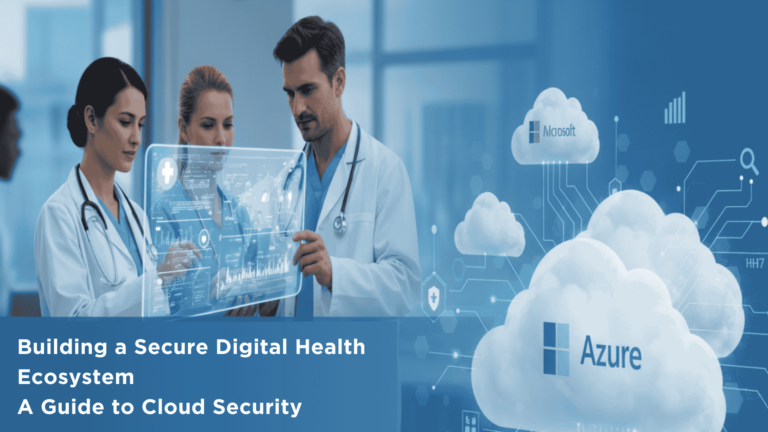
The healthcare industry is undergoing a seismic shift. Digital transformation is no longer a futuristic concept; it’s the present reality. Cloud technology is at the heart of this revolution, enabling healthcare organizations to enhance patient engagement, empower care teams with collaborative tools, and unlock powerful clinical and operational insights. Platforms like Microsoft Cloud for Healthcare, which bring together capabilities from Microsoft Azure, Dynamics 365, and Microsoft 365, are making it easier than ever to provide efficient, connected care.
However, this rapid digital adoption comes with a profound responsibility: protecting the sanctity of patient data. As we move sensitive Protected Health Information (PHI) to the cloud, the need for robust cloud security in healthcare becomes paramount. This isn’t just about compliance; it’s about building and maintaining patient trust.
This guide will walk you through the essential principles of healthcare cloud security, focusing on the shared responsibility model and the powerful tools available to create a secure, resilient, and trustworthy digital health ecosystem.
One of the most critical concepts to grasp when moving to the cloud is that security is not a one-sided affair. It’s an operational partnership between the cloud provider (like Microsoft) and you, the healthcare organization. Misunderstanding this model can lead to dangerous security gaps.
Microsoft builds its cloud services on a foundation of trust and security. This means they are responsible for the security of the cloud itself. This includes:
Essentially, Microsoft handles the security of the foundational infrastructure, so your organization doesn’t have to worry about managing physical servers or network hardware.
Microsoft builds its cloud services on a foundation of trust and security. This means they are responsible for the security of the cloud itself. This includes:
Essentially, Microsoft handles the security of the foundational infrastructure, so your organization doesn’t have to worry about managing physical servers or network hardware.
To effectively manage your side of the shared responsibility model, you need a powerful and integrated toolset. Microsoft provides a suite of solutions designed to work together, offering a comprehensive defense-in-depth strategy for healthcare cloud security.
You can’t protect what you don’t know you have. The first step in any robust security model is data governance, understanding where your sensitive data resides. Microsoft Purview is a unified data governance service that helps you discover, classify, and catalog your data across your entire environment, whether it’s in the cloud, on-premises, or in a hybrid setup.
For a healthcare organization using Microsoft Cloud for Healthcare, Purview can connect to and classify data within critical services like Microsoft Dataverse (the backbone for many Dynamics 365 applications) and Microsoft Power BI, ensuring you have a clear inventory of your PHI.
Once you know where your data is, you need to actively protect it. Microsoft Defender for Cloud is a comprehensive solution that provides both Cloud Security Posture Management (CSPM) and Cloud Workload Protection (CWPP). It serves three vital functions:
Crucially, Defender for Cloud protects the very tools your care teams use daily, including Microsoft Teams, Office 365, Power BI, and Dynamics 365, providing a unified security umbrella over your collaboration and data analytics platforms.
In a complex healthcare IT environment, security signals come from everywhere. Trying to monitor them in silos is ineffective. Microsoft Sentinel acts as your security command center, providing a cloud-native Security Information and Event Management (SIEM) and Security Orchestration, Automation, and Response (SOAR) solution.
Sentinel brings together signals from across your entire digital estate, including data from Microsoft Purview, Defender for Cloud, Power Apps, and Dynamics 365, to give you a complete, unified view of your security landscape. This allows your security team to detect threats more effectively, automate responses to common incidents, and reduce the noise so they can focus on what’s truly important.
Visibility is the cornerstone of effective security and compliance. Microsoft Cloud for Healthcare enables extensive logging and auditing across its core services. By configuring these logs, you gain a rich, detailed view of how data is being accessed and used. You can enable detailed activity logging for:
This granular visibility is essential for threat hunting, incident investigation, and demonstrating compliance with regulations like HIPAA.
Beyond security tools, the very structure of the data within Microsoft Cloud for Healthcare is designed with security and interoperability in mind. The platform’s data models and entities are aligned with the HL7 FHIR (Release 4) standards.
This standardization is crucial for several reasons. It ensures that data, whether clinical, financial, or administrative, is organized in a consistent, predictable way. This makes it easier to manage, connect data from disparate systems, and apply security policies uniformly. A well-structured data model is inherently easier to secure and govern than a chaotic collection of disconnected data silos. This foundational approach supports everything from creating a longitudinal patient record to enabling secure secondary use of anonymized data for research.
As you navigate your organization’s digital transformation, keep these core principles of cloud security at the forefront:
By adopting a proactive, strategic approach to healthcare cloud security, you can confidently harness the power of the cloud to design a healthier, more efficient, and more secure future for your patients and care teams